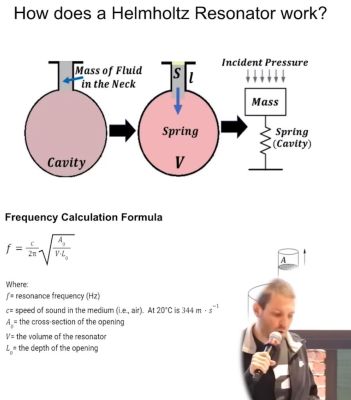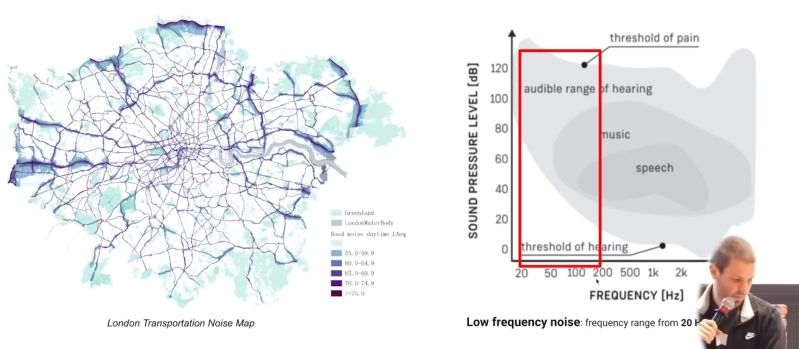One inevitable aspect of cities and urban life in general is that it is noisy, with traffic being one of the main sources of noise pollution. Finding a way to attenuate especially the low-frequency noise of road traffic was the subject of [Joe Krcma]’s Masters Thesis, the results of which he gave a talk on at the Portland Maker Meetup Club after graduating from University College London. The chosen solution in his thesis are Helmholtz resonators, which are a kind of acoustic spring. Using a carefully selected opening into the cavity, frequencies can be filtered out, and extinguished inside the cavity.

As examples of existing uses of Helmholtz resonators in London, he points at the Queen Elizabeth Hall music venue, as well as the newly opened Queen Elizabeth Line and Paddington Station. For indoor applications there are a number of commercial offerings, but could this be applied to outdoor ceramics as well, to render urban environments into something approaching an oasis of peace and quiet?
For the research, [Joe]’s group developed a number of Helmholtz resonator designs and manufacturing methods, with [Joe] focusing on clay fired versions. For manufacturing, 3D printing of the clay was attempted, which didn’t work out too well. This was followed by slip casting, which allowed for the casting of regular rectangular bricks.
But after issues with making casting hollow bricks work, as well as the cracking of the bricks during firing in the kiln, the work of another student in the group inspired [Joe] to try a different approach. The result was a very uniquely shaped ‘brick’ that, when assembled into a wall, forms three Helmholtz resonators: inside it, as well as two within the space with other bricks. During trials, the bricks showed similar sound-deadening performance as foam and wood. He also made the shape available on Thingiverse, if you want to try printing or casting it yourself.















Have they developed a method of cleaning them inside?
Would insects make a home of these? At least the EV trend should make vehicular noise less of a problem.
insects would _absolutely_ colonize those. probably mosses and algae too, unless rainwater can drain out of them somehow —- because mounting the opening horizontally _won’t_ be enough to keep rainwater out.
I live next to a big road, at speed there is almost no difference in noice from a gasoline car or an electric one, of you remove the few “souped up” ones with illegal exhausts
I second this as someone who lives on a main road.
Engines are very quiet nowadays for the most part.
Most of the noise is tyres and aerodynamic.
Again, midlife crises notwithstanding.
The noise from cars comes, for the most part, from the tires touching the ground. Not actually from the engine.
Insects? Those cavities look like they’d have opossums warring with birds for yard dominance within hours at my place.
Although that’d take care of the bugs.
Tire noise is a big component of road noise at highway speed, so EV ‘s don’t help that much
Yes. In fact Joe in the video I saw says he hopes birds and bugs do live in them because it could help reduce noise even more.
I love the idea of building materials seasoning the noise, but for someone in London, building a wall out of pigeon nests seems an odd idea…
Nice insect and bird houses.
You misspelled “rat”.
B^)
Detonating an EMP device over a city should quiet things down…
Double or triple pane windows go along way to reduce noise in homes
A Helmholtz resonator is usually a high-Q device — where’s the lossy element that turns the sound into heat? It’s pretty well known that those “sound walls” built alongside freeways don’t absorb anything — they just make all the noise bounce and show up someplace else.
I like to think of resonators as a means to enhance coupling of the pressure field to loss mechanisms. Even without a liner, there will be vortex generation, which is not present in mere scattering.
Would be nice if someone came up with a more intuitive treatment.
neglected,as usual when empty promises and claims are looking for money,is the fact that the
types of noise that cause the most psychological
distress and long term damage are 1:low frequency sound,that will require lots of helmhlotz
resonators that are about the size of shipping cans,everywhere and 2:sounds that are doplering
and generaly only get WORSE when you mess with
them.
so living on a hill or a tall building will always
work,as the sound pressure diminishes with
the cube of the distance,the other option is
perfect acoutical (hermetic),sealing on structures
that have a lot of mass:ie this is physics and the only thing that will stop a high energy low frequency sound is mass,or distance(air mass)
Generally, sound pressure falls with the square of distance.
Sound pressure is not the inverse square of distance (that’s for sound intensity), not the inverse cube (not sure where that came from), it’s just plain inverse. But we hear logarithmically, so it’s more helpful to think of every doubling of distance as an equal notch lower in volume.
” most psychological distress”
That noise is churchbells and mosques, it annoys the hell out of normal people.
I would not say that’s such low frequency though.
A sound that can also get annoying is birds in the city, they make louder noise to compensate for ambient noise and are often very repetitive, and high pitched (except the damn pigeons with their cooing, which is lower pitched).
And then there is the construction noise, and people using electrical sanders for hours and hours and days and days.
Wildlife? Minor problem to fix. It’s called a screen. Or integrate the neck into a screened stainless tube.
Then it’ll catch debris like leaves and bits of paper and plastic floating in the wind.
Birds and bats will absolutely love those bird houses and bat houses. Colony insects such as bees and wasps will also colonize them.
Swifts would likely get good use out of these and help keep the insect populations down around the area. Good chance of sparrows too, and if they settle en-masse in the area would possibly lead to more noise than the cars they’re trying to keep down.
I guess insects would be a bigger concern than birds anyway. Stopping them getting in would require quite a dense mesh compared to birds.
I watched the video of Joe’s experiment some time back, and I was impressed with the results. Their choice of clay as a material was kind of arbitrary and I suggest hindered their pace and scaleability significantly. I see a lot of energy here spent on seeing potential hassles, when the positive results of a visually interesting screen that can also make the heard environment so much more livable is the residue I choose from this. If these “bricks” were made of a “printable,” durable and UV-stable material, they could be a boon to many people.